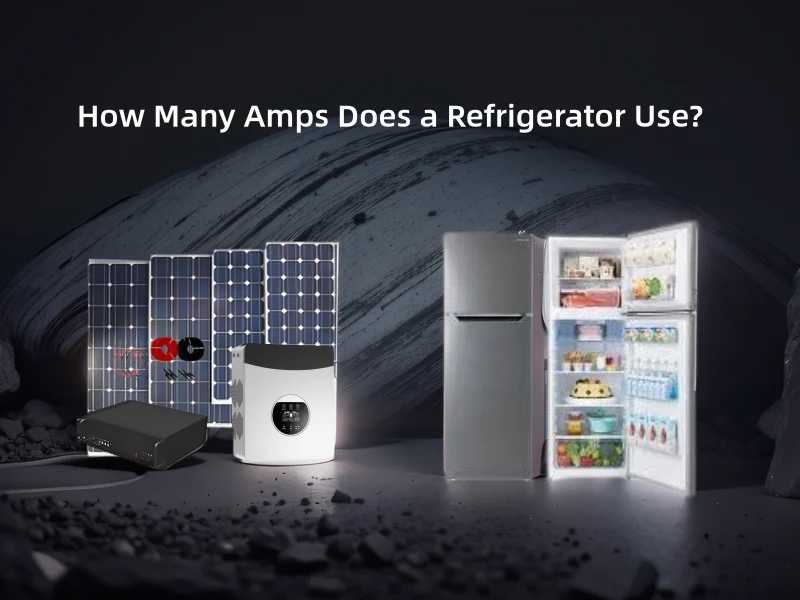The battery size for a 1000-watt inverter must be just right in order to have an efficient and reliable delivery of power. The size of the battery depends on factors such as the consumption power of the inverter, desired runtime, and the voltage and capacity of the battery. Now let's discuss in detail the selection of the best battery for your system.
Key Factors to Consider
1. Power Consumption and Current Requirements
A 1000-watt inverter running at full load draws approximately 83.33 amps from a 12-volt battery. The formula to calculate the current is:
Current(A)=Power (W)Voltage (V)
For a 12V system:
Current=100012≈83.33A
This figure represents the load the inverter places on the battery during operation.
See Also: Wh to Ah Converter
2. Battery Capacity and Runtime
Battery capacity, measured in ampere-hours (Ah), determines how long the inverter can run. Use this formula:
Battery Capacity (Ah)=Current (A)×Runtime (hours)
For 1 hour runtime:
Battery Capacity=83.33×1=83.33Ah
For 2 hours runtime:
Battery Capacity=83.33×2=166.66Ah
To ensure safety and account for inefficiencies, it’s recommended to choose a battery with a slightly higher capacity. For example, a 200Ah battery would be a better fit for longer runtimes or higher efficiency.
3. System Efficiency
Inverters are not 100% efficient. A typical inverter efficiency is around 90%. This means you’ll need additional capacity to compensate for losses. Adjust the battery size using this formula:
Adjusted Capacity=Required CapacityEfficiency
For a 90% efficient inverter and a required capacity of 166.66Ah:
Adjusted Capacity=166.660.9≈185.18Ah
Battery Configuration
Depending on your system’s requirements, you may need to use multiple batteries:
1. Parallel Configuration
- Keeps the voltage constant while increasing capacity.
- Example: Two 12V 100Ah batteries connected in parallel provide 200Ah at 12V.
2. Series Configuration
- Increases voltage while keeping capacity the same.
- Example: Two 12V 100Ah batteries in series provide 24V at 100Ah, often used for inverters requiring higher input voltage.
Example Scenarios
Scenario 1: Short Runtime (1 Hour)
- Inverter Power: 1000W
- Battery Voltage: 12V
- Desired Runtime: 1 hour
- Battery Needed: A single 12V 100Ah battery could suffice but a 12V 150Ah is recommended to account for efficiency losses.
Scenario 2: Extended Runtime (5 Hours)
- Inverter Power: 1000W
- Battery Voltage: 12V
- Desired Runtime: 5 hours
- Total Energy Needed:
Energy (Wh)=1000×5=5000Wh
For a 12V system:
Capacity (Ah)=500012≈416.66Ah
You would need four 12V 100Ah batteries connected in parallel to achieve this capacity.
Choosing the Right Battery Type
1. Lead-Acid Batteries
- Affordable and reliable but with lower energy density.
- Require regular maintenance and limited to shallow discharge cycles.
2. Lithium-Ion Batteries
- High energy density, longer lifespan, and faster charging.
- Ideal for extended runtime and frequent use but with a higher upfront cost.
Recommendation: For a 1000-watt inverter, lithium iron phosphate (LiFePO4) batteries are often the best choice due to their durability and efficiency.
Thought-Provoking Questions
- How does selecting a higher-efficiency inverter impact the battery size you need?
- Could renewable sources like solar panels further optimize your system by continuously charging the battery?
The understanding of the nuances of battery sizing for a 1000-watt inverter would ensure that the operation of such equipment is smooth and its wear is limited. From instantaneous to longterm requirements of power, estimation of correct battery capacity becomes the first step towards an efficient energy system.






 Afrikaans
Afrikaans Albanian
Albanian Amharic
Amharic Arabic
Arabic Armenian
Armenian Azerbaijani
Azerbaijani Basque
Basque Belarusian
Belarusian Bengali
Bengali Bosnian
Bosnian Bulgarian
Bulgarian Catalan
Catalan Cebuano
Cebuano Chichewa
Chichewa Chinese (Simplified)
Chinese (Simplified) Chinese (Traditional)
Chinese (Traditional) Corsican
Corsican Croatian
Croatian Czech
Czech Danish
Danish Dutch
Dutch English
English Esperanto
Esperanto Estonian
Estonian Filipino
Filipino Finnish
Finnish French
French Frisian
Frisian Galician
Galician Georgian
Georgian German
German Greek
Greek Gujarati
Gujarati Haitian Creole
Haitian Creole Hausa
Hausa Hawaiian
Hawaiian Hebrew
Hebrew Hindi
Hindi Hmong
Hmong Hungarian
Hungarian Icelandic
Icelandic Igbo
Igbo Indonesian
Indonesian Irish
Irish Italian
Italian Japanese
Japanese Javanese
Javanese Kannada
Kannada Kazakh
Kazakh Khmer
Khmer Korean
Korean Kurdish (Kurmanji)
Kurdish (Kurmanji) Kyrgyz
Kyrgyz Lao
Lao Latin
Latin Latvian
Latvian Lithuanian
Lithuanian Luxembourgish
Luxembourgish Macedonian
Macedonian Malagasy
Malagasy Malay
Malay Malayalam
Malayalam Maltese
Maltese Maori
Maori Marathi
Marathi Mongolian
Mongolian Myanmar (Burmese)
Myanmar (Burmese) Nepali
Nepali Norwegian
Norwegian Pashto
Pashto Persian
Persian Polish
Polish Portuguese
Portuguese Punjabi
Punjabi Romanian
Romanian Russian
Russian Samoan
Samoan Scottish Gaelic
Scottish Gaelic Serbian
Serbian Sesotho
Sesotho Shona
Shona Sindhi
Sindhi Sinhala
Sinhala Slovak
Slovak Slovenian
Slovenian Somali
Somali Spanish
Spanish Sundanese
Sundanese Swahili
Swahili Swedish
Swedish Tajik
Tajik Tamil
Tamil Telugu
Telugu Thai
Thai Turkish
Turkish Ukrainian
Ukrainian Urdu
Urdu Uzbek
Uzbek Vietnamese
Vietnamese Welsh
Welsh Xhosa
Xhosa Yiddish
Yiddish Yoruba
Yoruba Zulu
Zulu